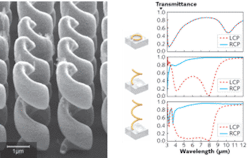In his Photonic Devices and Applications Plenary presentation, “Photonic Metamaterials: Optics Starts Walking on Two Feet,” at the 2009 SPIE Optics and Photonics Conference (Aug. 2–6) Martin Wegener, professor and nanostructures expert at Universität Karlsruhe (Karlsruhe, Germany), described one of the first practical applications for metamaterials: a three-dimensional (3-D) chiral metamaterial structure that can be used as a broadband circular polarizer.1 Wegener said the device, jointly developed at Universität Karlsruhe and Forschungszentrum Karlsruhe in der Helmholtz-Gemeinschaft (also in Karlsruhe, Germany), is a demonstration of how metamaterials exploit the manipulation of both the electric- and magnetic-field contributions of light—hence the reference to light propagation (walking) in the z direction with the orthogonal electric and magnetic fields acting as the two feet.
In addition to proposed implementations including perfect lenses and invisibility cloaking, metamaterials can exhibit strong chirality—a phenomenon manifested by DNA, cholesteric liquid crystals, and circular metal helices—in which these materials mix electrical and magnetic responses such that magnetic dipoles are excited by the electric component of the light field and, conversely, electric dipoles are excited by the magnetic component of the light field. One such chiral element can be created by essentially modifying a split-ring resonator (SRR) into a helical structure. This structure has the added feature of influencing the polarization state of light that enters it.
Broadband response
The internal response of a chiral optical material is typically narrowband in nature; however, if Bragg resonances between multiple structures are exploited, a broadband response can be observed. Analogous to the case of multiple, coupled SRRs where magnetization waves can form bands out of sharp individual resonances, multiple helical metamaterial structures can convert narrowband polarization responses to a broadband response. These attributes are the basis for a circular polarizer comprised of an array of metallic helices in close proximity, representing the first practical implementation of a 3-D metamaterial.
Fabricating the chiral structure
The circular polarizer begins as a 25-nm-thick film of indium tin oxide evaporated as the cathode onto a glass substrate. A 10-µm-thick layer of positive-tone photoresist is exposed using a commercial 3-D direct-laser-writing (DLW) system as a series of helical structures (each roughly 1200 nm in diameter and with 2000 nm pitch height) in a 40 × 40 µm footprint. After etching to remove the exposed polymer, which essentially creates a porous mold, gold is electrochemically deposited into the helical forms. The supporting resist is then removed to reveal the array of gold helices (see figure).
Using a Fourier-transform IR spectrometer modified with a linear polarizer and mid-IR super-achromatic quarter-wave plate combined with a microscope, the researchers measured spectral response of the structure for left circularly polarized (LCP) and right circularly polarized (RCP) light over a range spanning 3.0 to 6.5 µm. For even longer wavelengths the glass substrate is totally opaque. Calculations showed that the device transmits either LCP or RCP light input along the helices’ axis in a range from approximately 3.5 to 8.0 µm while blocking the other, depending on the handedness of the gold chiral structures. The researchers point out that this practical structure could be physically modified to operate over a different wavelength range.
REFERENCE
- J. K. Gansel et al., Science Express online, 10.1126/science.1177031 (Aug. 20, 2009).

